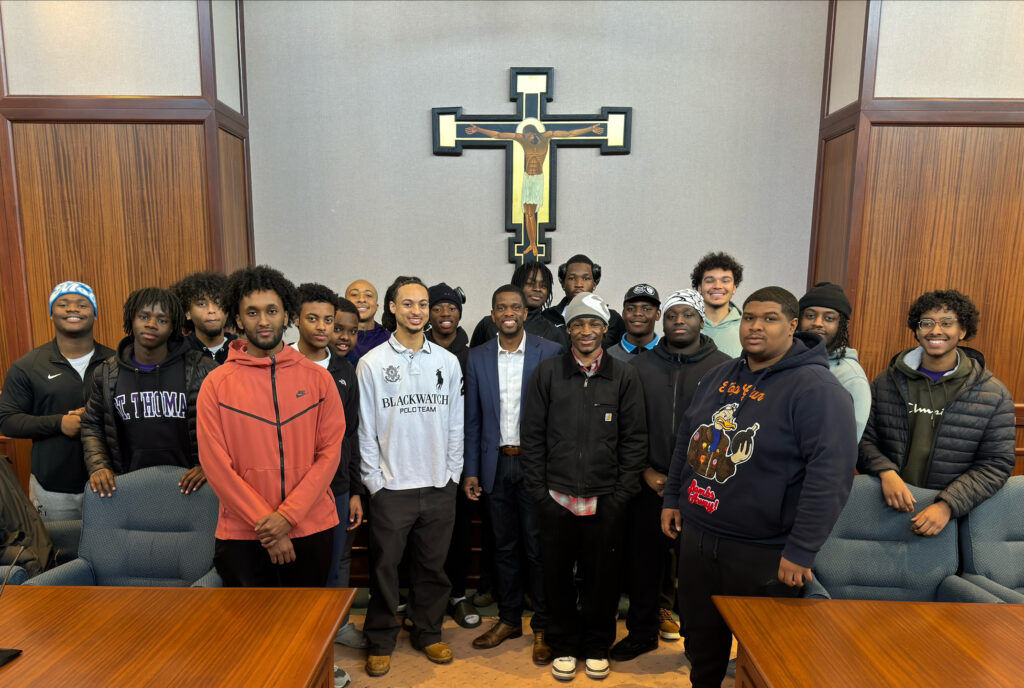UST Libraries review preliminary results of LibQual survey
By Dan Gjelten
Director of Libraries
In the fall of 2008, as we began the yearlong celebration of 50 years of service to the UST community at this location, the UST Libraries contracted with the Association of Research Libraries to conduct the LibQual survey among our users. This highly regarded survey has been completed more than 1,000 times at 500 college and university libraries around the world.
The goals of the survey as stated by LibQual:
 Dan Gjelten
Dan Gjelten
- Foster a culture of excellence in providing library service
- Help libraries better understand user perceptions of library service quality
- Collect and interpret library user feedback systematically over time
- Provide libraries with comparable assessment information from peer institutions
- Identify best practices in library service
- Enhance library staff members' analytical skills for interpreting and acting on data
The UST Libraries were interested in finding new ways of measuring the quality of our services in the three main areas covered by the questions in the survey:
- The quality and affect of services provided by staff
- The quality and scope of the libraries’ content collections (print and electronic)
- The quality of the library’s physical spaces
We conducted the online survey for two weeks in October and had a total response rate of more than 22 percent. The survey was sent to students (undergraduate and graduate), faculty and staff. Of all respondents, 25 percent described their academic areas as business, 17 percent as humanities, 13 percent as social sciences, 12 percent as education and 8 percent as science and math, and the rest were distributed among other disciplines. Fifty-nine percent of our respondents were over the age of 30, and 21 percent were between 18 and 22.
(In addition to the questions, respondents were given the chance to comment. A few of the more than 200 comments we received are included in the column to the right.)
The answers to the 27 questions in the survey (22 standard and five "local") had three dimensions each:
- What is the minimum acceptable level of service?
- What is the desired level of service?
- What is the perceived level of service?
Asking the questions in this way allows the library to measure the degree to which we are meeting our user’s expectations. We interpret "desired" to be an indication of the importance that our users place on each of these aspects of library service – giving us a good idea of what our users really want us to be doing. The gap between the perceived level of quality and the desired level of quality, then, is a measure of the opportunity to improve library services. In a few cases, we learned that we were actually exceeding user expectations – with "perceived" levels of quality that were higher than "desired"– and for one population, on one question, we fell below minimum expectations.
Our preliminary findings
As we began to look at the preliminary results, it became clear that the user groups had differing expectations of the libraries at UST. Faculty are most concerned about having resources that support their work (understanding that "work" can mean teaching, research or consulting.) Faculty are happy with our interlibrary loan services and feel that the libraries are doing well at providing community and learning spaces for students, but felt we need more extensive collections. We are more aware now that there is room for improvement in communicating and describing the full extent of our collections to the faculty – many are unaware of the resources that the libraries’ already own.
Graduate students, on the other hand, care most for the ability to use our resources remotely – with a Web site that makes our electronic services and resources as easy to use as possible. When they come to the library in person, they want a building that is easy to navigate and with working and accessible technology – they don’t want to waste their time.
Our undergraduate populations clearly care about the library as place – with plentiful and well-functioning equipment, places for group study as well as places to "get away." Interacting with library staff isn’t necessarily a priority for the undergraduate population, which would like to do their work on their own and be able to navigate and search without help. Undergraduates also place a high value on a clear and easy to navigate Web site. Our UST staff colleagues appreciate library staff who are courteous and willing to help – they, among all of our user groups, seem to value a personal connection to the library staff.
For each of our constituent groups, we see opportunities for improved library services that more closely address the identified desires and needs of our users. We will be increasingly focused on designing and developing a Web site that is clear and easy to navigate, and which makes available a wide and deep collection of information resources. We also will work to communicate more effectively so that all of our users know what the libraries own. Creating physical and virtual library spaces that are sophisticated, information-rich and “easy to use” is a challenge, and one that the libraries take seriously.
More data and analysis will be forthcoming from the LibQual survey and the libraries intend to continue the conversation within the UST community with the goal of continuous improvement in library collections and services.
We have posted the full text of the survey along with our preliminary analysis on our LibQual Web site, and further additions will be added to this page and announced on our UST Library blog.






